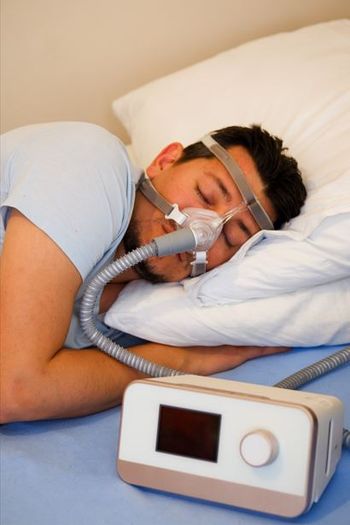
Corticosteroids for Asthma Raise Sleep Apnea Risk
Inhaled corticosteroids may contribute to the high prevalence of obstructive sleep apnea among patients with asthma, a study showed.
Inhaled corticosteroids may contribute to the high prevalence of obstructive sleep apnea (OSA) among patients with asthma, according to the results of a small pilot study.
“In a previous study, we found that OSA is associated with inhaled corticosteroid use,” Mihaela Teodorescu, MD, Associate Professor of Medicine at the University of Wisconsin School of Medicine and Public Health in Madison, told ConsultantLive. “Corticosteroids are known to cause weight gain and fat redistribution in the neck. They also affect muscle function, so perhaps they cause upper airway muscle dysfunction.”
Dr Teodorescu noted that the patency of the upper airway where OSA occurs is fully dependent on muscle function. If the muscle is affected by corticosteroids, it can become compromised.
The new study evaluated 18 patients (14 women, 4 men) with mild asthma who were taking 1760 µ/d of inhaled fluticasone propionate. Dr Teodorescu and colleagues monitored the patients for changes in the “collapsibility” of their upper airways during sleep and their tongue function. They measured the amount of fat in the neck tissues of 3 patients with MRI scans.
“We found that during sleep, the upper airway was more collapsible and more predisposed to closure in patients who were older, males, and had worse asthma to start with,” Dr Teodorescu said. “Although only a small subset of patients showed worsening, the entire group showed subtle tongue muscle changes, which over the long term could translate into upper airway dysfunction.”
She added that there was an increase in the neck fat content in the upper airway of the 3 patients tested with MRI, even though airway collapsibility did not change.
Dr Teodorescu emphasized that the effects of the medication were tested for only for 4 months and that more studies are needed in a larger group of more diverse patients in regard to age, sex, and other important baseline characteristics. She said the main question is, What happens with long-term use of inhaled corticosteroids? Longer studies, with follow-up for 12 months or longer, are needed to fully understand the effects, she noted.
The baseline characteristics of the study skewed young, with an average age of 26 years, and the older subgroup (age 36 years, on average) experienced a worsening in their airway collapsibility, Dr Teodorescu said. “Among this older group of patients, there may have been changes in muscle and upper airway structure over time, and perhaps this predisposed them to the effects of corticosteroids.”
In addition, OSA tends to affect men more than women, she noted. “Premenopausal women appear to be protected from the effects of corticosteroids, but what happens when women go through menopause? Many asthmatic women have disease worsening at menopause.”
Dr Teodorescu recommends maintaining patients on inhaled corticosteroid treatment “because it works for asthma. Tailor treatment to the patient’s needs, and monitor frequently for OSA symptoms.”
Patients with asthma in whom OSA develops often have cardiovascular consequences and poorer quality of life, which tends to worsen their asthma, Dr Teodorescu said, adding, “The response is often to give more corticosteroids, but that may place them at higher risk for OSA, which makes the asthma worse, and sets them up for a vicious cycle.”
The researchers published their
Newsletter
Enhance your clinical practice with the Patient Care newsletter, offering the latest evidence-based guidelines, diagnostic insights, and treatment strategies for primary care physicians.



















































































































































































































































































